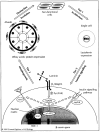A hierarchy of ECM-mediated signalling regulates tissue-specific gene expression
- PMID: 8573350
- PMCID: PMC2933201
- DOI: 10.1016/0955-0674(95)80117-0
A hierarchy of ECM-mediated signalling regulates tissue-specific gene expression
Abstract
A dynamic and reciprocal flow of information between cells and the extracellular matrix contributes significantly to the regulation of form and function in developing systems. Signals generated by the extracellular matrix do not act in isolation. Instead, they are processed within the context of global signalling hierarchies whose constituent inputs and outputs are constantly modulated by all the factors present in the cell's surrounding microenvironment. This is particularly evident in the mammary gland, where the construction and subsequent destruction of such a hierarchy regulates changes in tissue-specific gene expression, morphogenesis and apoptosis during each developmental cycle of pregnancy, lactation and involution.
Figures


References
-
- Hay ED. Cell Biology of the Extracellular Matrix. New York: Plenum Press; 1981.
-
- Adams JC, Watt FM. Regulation of development and differentiation by the extracellular matrix. Development. 1993;117:1183–1198. - PubMed
-
- Hynes RO. Integrins: versatility, modulation and signalling in cell adhesion. Cell. 1992;69:11–25. - PubMed
-
- Clark EA, Brugge JS. Integrins and signal transduction pathways: the road taken. Science. 1995;268:233–239. - PubMed
-
A comprehensive review of the numerous points of intersection between signal transduction pathways initiated by the extracellular matrix, cytokines, growth factors, and differentiation factors.
Publication types
MeSH terms
Grants and funding
LinkOut - more resources
Full Text Sources
Other Literature Sources

